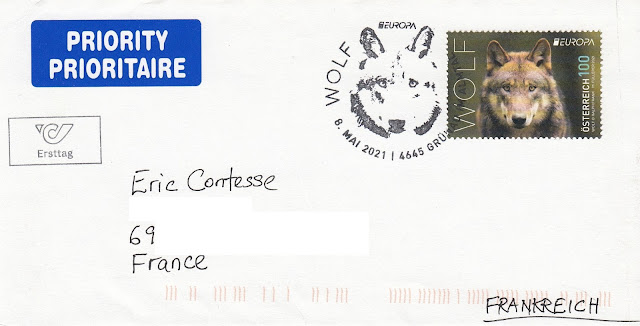Timbre EUROPA 2021 (Faune en voie de disparition) sur FDC d'Autriche
Comme de coutume, la poste autrichienne n'a mis en circulation, le 8 mai 2021, qu'un seul timbre EUROPA, consacré cette année à la "faune nationale en voie de disparition" ("Gefährdete nationale Wildtiere" en allemand).
Ce timbre (1€, tirage : 240000), imprimé aux Pays-Bas par Joh. Enschedé Stamps B.V., a été conçu par Marion Füllerer à partir d'une photographie d'un loup ("Wolf" en allemand) par Ralph Frank.
Depuis 2010, Ralph Frank a fait de nombreuses photographies liées à la faune sauvage, dont une partie de la commercialisation revient à des associations comme le WWF.
J'aime beaucoup cette photographie montrant ce loup qui semble nous regarder dans les yeux et nous interroger sur notre responsabilité concernant sa disparition dans de nombreuses régions d'Europe.
Un grand merci Edna pour l'envoi de ce pli Premier Jour, avec TAD du village de Grünau im Almtal (Haute-Autriche), concernant ce timbre !
Sous ses formes sauvages, le loup gris (Canis lupus) a été en effet peu à peu exterminé par l'homme dans plusieurs zones de son aire de répartition originelle, en particulier au 19ème siècle.
As usual, the Austrian Post has put into circulation, on May 8, 2021, only one EUROPA stamp, dedicated this year to "Endangered National Wildlife" ("Gefährdete nationale Wildtiere" in German). This stamp (€ 1.00, print run: 240,000), printed in the Netherlands by Joh. Enschedé Stamps B.V., was designed by Marion Füllerer from a photograph of a wolf by Ralph Frank.
Since 2010, Ralph Frank has taken numerous photographs related to wildlife, part of the income of which goes to associations such as WWF.
I really love this photograph showing this wolf that seems to look us in the eyes and question us about our responsibility for his disappearance in many parts of Europe.
A big thank you Edna for sending this First Day cover, with postmark from the village of Grünau im Almtal (Upper Austria), regarding this stamp!
In its wild forms, gray wolf (Canis lupus) was indeed gradually exterminated by humans in several areas of its original range, especially in the 19th century.
En Autriche, la principale aire de répartition des loups était la Styrie, où ils ont été recensés jusqu'en 1882, l'année où le dernier loup du pays a été tué.
Depuis 1970, le nombre d'observations de loups dans la zone frontalière entre l'Autriche et la République tchèque a augmenté. Entre 1990 et 2004, une dizaine de loups ont été aperçus en Haute-Autriche.
En 2010, le WWF a estimé qu'il y avait trois à cinq animaux en Autriche dans les Länder de l'est du pays et dans le Tyrol, la Commission européenne ayant spécifié deux à huit animaux pour l'Autriche en 2013. Ces loups proviennent de trois populations différentes, originaires des Alpes occidentales, des Balkans et des Carpates.
En 2016, une famille de loups (2 adultes et 2 jeunes) a été observée dans le pays, une première depuis plus de 100 ans...
In the 21st century, there are only about 300,000 individuals left in the world, mainly in large areas that have remained wild, such as the taiga of Siberia and Canada or the steppes and mountain ranges of Europe and Central Asia.
In Austria, the main range of wolves was Styria, where they were obesrved until 1882, the year when the last wolf in the country was killed.
Since 1970, the number of wolf sightings in the border area between Austria and Czech Republic has increased. Between 1990 and 2004, around ten wolves were seen in Upper Austria.
In 2010, the WWF estimated that there were three to five animals in Austria in the eastern Länder of the country and in Tyrol, with the European Commission having specified two to eight animals for Austria in 2013. These wolves come from three different populations, originating in the Western Alps, the Balkans and the Carpathians.
In 2016, a family of wolves (2 adults and 2 young) was observed in the country, a first for over 100 years ...

Aucun commentaire:
Enregistrer un commentaire